Event Supply and Logistics: Operational and Risk Management Report
VerifiedAdded on 2021/09/27
|11
|2841
|157
Report
AI Summary
This report provides a detailed overview of event supply and logistics, encompassing crucial aspects such as supply chain management, logistics, and event planning. It delves into the intricacies of operational management, space management, and risk management within the event context. The report explores the fundamentals of supply chain supervision, including consumer interaction, scheduling, purchasing, inventory control, processing, and transportation. It highlights the importance of event planning, emphasizing the roles of event planners, the planning process, and the analysis of event experiences. Furthermore, it examines operational management strategies, logistic management, and the significance of risk management in mitigating potential issues. The report also emphasizes the crucial role of customer service within the supply chain, discussing its impact on customer satisfaction and business success. Overall, the report offers valuable insights into the effective management of event supply and logistics, providing a comprehensive understanding of key concepts and strategies.

Event Supply and Logistics
Paraphrase This Document
Need a fresh take? Get an instant paraphrase of this document with our AI Paraphraser
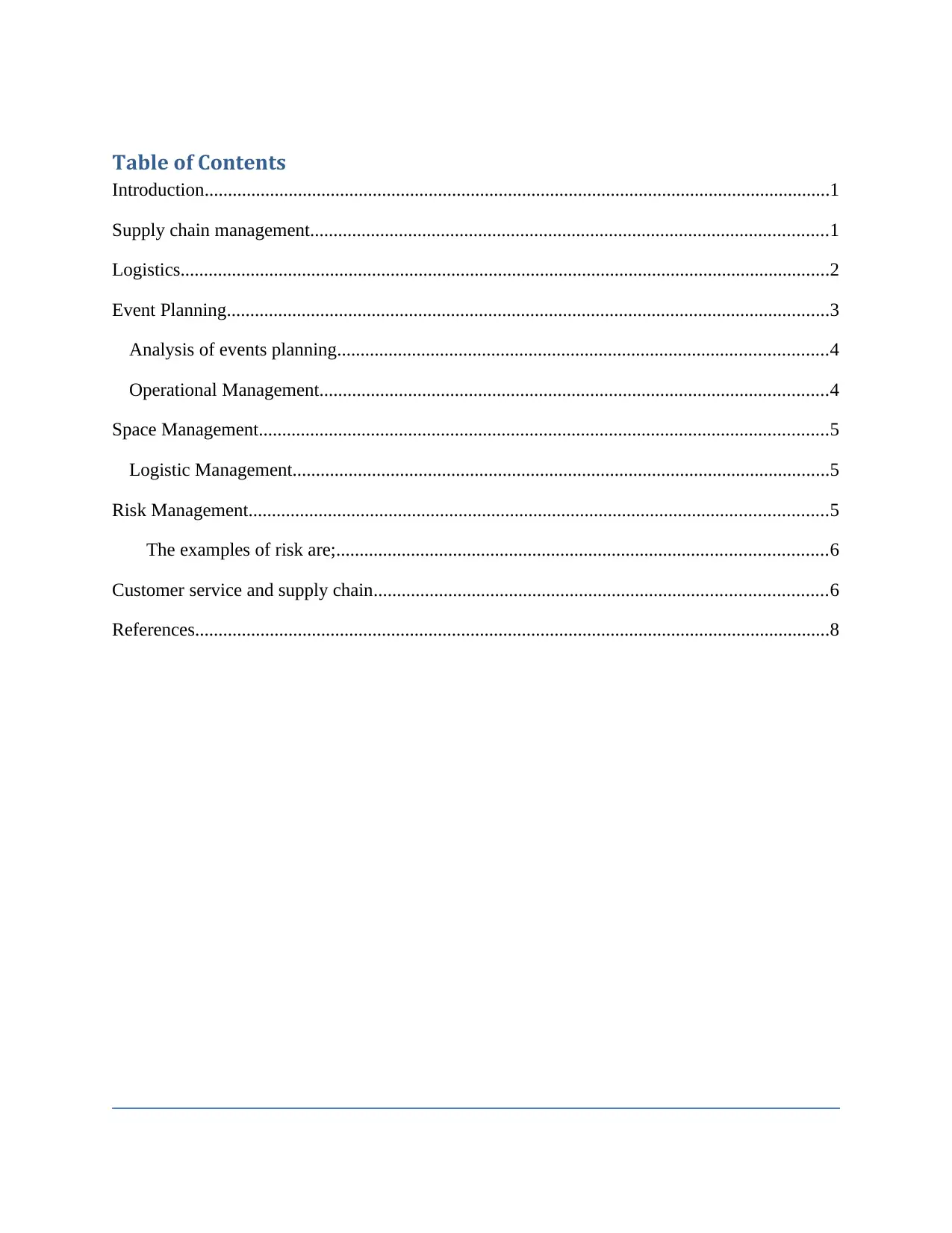
Table of Contents
Introduction......................................................................................................................................1
Supply chain management...............................................................................................................1
Logistics...........................................................................................................................................2
Event Planning.................................................................................................................................3
Analysis of events planning.........................................................................................................4
Operational Management.............................................................................................................4
Space Management..........................................................................................................................5
Logistic Management...................................................................................................................5
Risk Management............................................................................................................................5
The examples of risk are;.........................................................................................................6
Customer service and supply chain.................................................................................................6
References........................................................................................................................................8
Introduction......................................................................................................................................1
Supply chain management...............................................................................................................1
Logistics...........................................................................................................................................2
Event Planning.................................................................................................................................3
Analysis of events planning.........................................................................................................4
Operational Management.............................................................................................................4
Space Management..........................................................................................................................5
Logistic Management...................................................................................................................5
Risk Management............................................................................................................................5
The examples of risk are;.........................................................................................................6
Customer service and supply chain.................................................................................................6
References........................................................................................................................................8
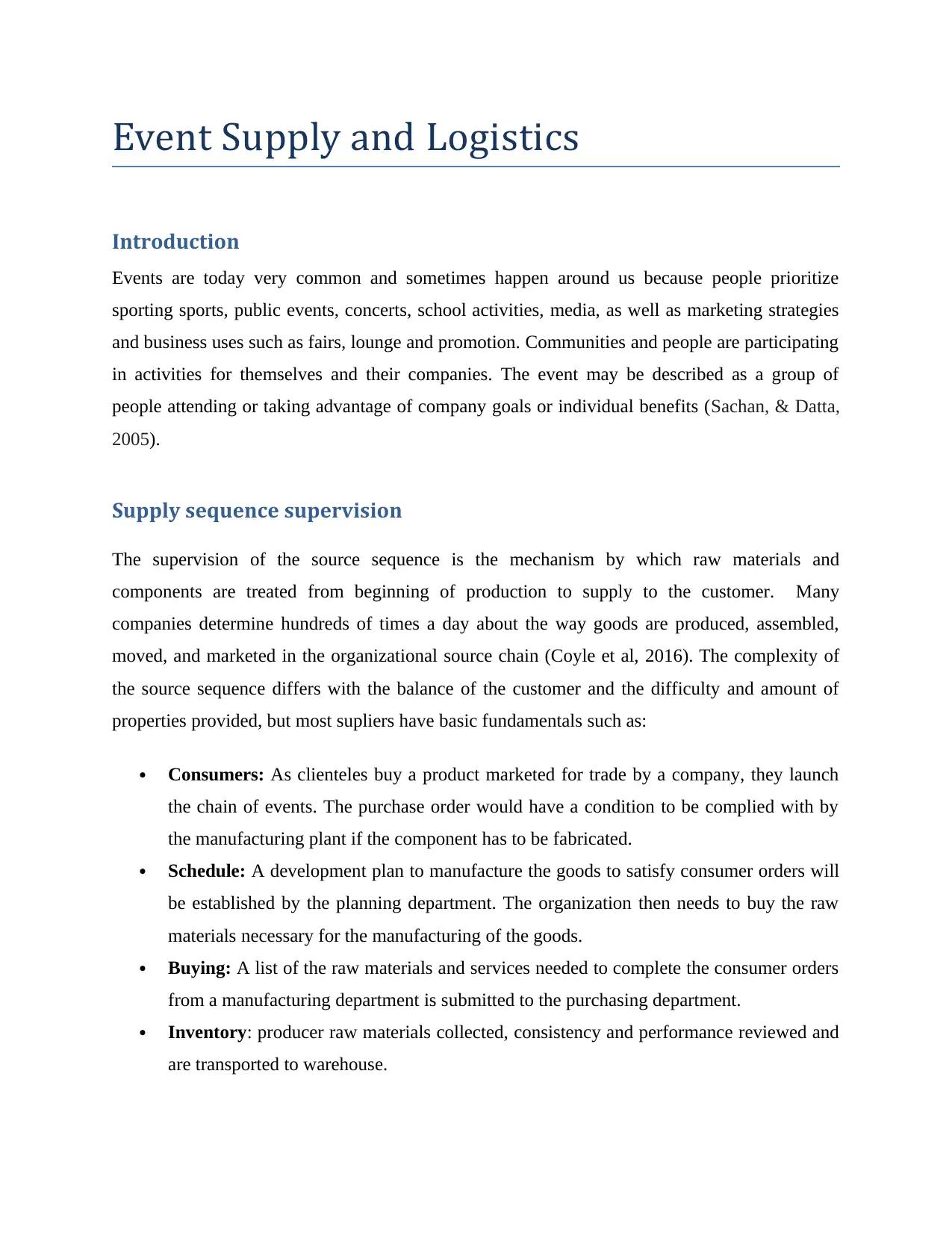
Event Supply and Logistics
Introduction
Events are today very common and sometimes happen around us because people prioritize
sporting sports, public events, concerts, school activities, media, as well as marketing strategies
and business uses such as fairs, lounge and promotion. Communities and people are participating
in activities for themselves and their companies. The event may be described as a group of
people attending or taking advantage of company goals or individual benefits (Sachan, & Datta,
2005).
Supply sequence supervision
The supervision of the source sequence is the mechanism by which raw materials and
components are treated from beginning of production to supply to the customer. Many
companies determine hundreds of times a day about the way goods are produced, assembled,
moved, and marketed in the organizational source chain (Coyle et al, 2016). The complexity of
the source sequence differs with the balance of the customer and the difficulty and amount of
properties provided, but most supliers have basic fundamentals such as:
Consumers: As clienteles buy a product marketed for trade by a company, they launch
the chain of events. The purchase order would have a condition to be complied with by
the manufacturing plant if the component has to be fabricated.
Schedule: A development plan to manufacture the goods to satisfy consumer orders will
be established by the planning department. The organization then needs to buy the raw
materials necessary for the manufacturing of the goods.
Buying: A list of the raw materials and services needed to complete the consumer orders
from a manufacturing department is submitted to the purchasing department.
Inventory: producer raw materials collected, consistency and performance reviewed and
are transported to warehouse.
Introduction
Events are today very common and sometimes happen around us because people prioritize
sporting sports, public events, concerts, school activities, media, as well as marketing strategies
and business uses such as fairs, lounge and promotion. Communities and people are participating
in activities for themselves and their companies. The event may be described as a group of
people attending or taking advantage of company goals or individual benefits (Sachan, & Datta,
2005).
Supply sequence supervision
The supervision of the source sequence is the mechanism by which raw materials and
components are treated from beginning of production to supply to the customer. Many
companies determine hundreds of times a day about the way goods are produced, assembled,
moved, and marketed in the organizational source chain (Coyle et al, 2016). The complexity of
the source sequence differs with the balance of the customer and the difficulty and amount of
properties provided, but most supliers have basic fundamentals such as:
Consumers: As clienteles buy a product marketed for trade by a company, they launch
the chain of events. The purchase order would have a condition to be complied with by
the manufacturing plant if the component has to be fabricated.
Schedule: A development plan to manufacture the goods to satisfy consumer orders will
be established by the planning department. The organization then needs to buy the raw
materials necessary for the manufacturing of the goods.
Buying: A list of the raw materials and services needed to complete the consumer orders
from a manufacturing department is submitted to the purchasing department.
Inventory: producer raw materials collected, consistency and performance reviewed and
are transported to warehouse.
⊘ This is a preview!⊘
Do you want full access?
Subscribe today to unlock all pages.

Trusted by 1+ million students worldwide
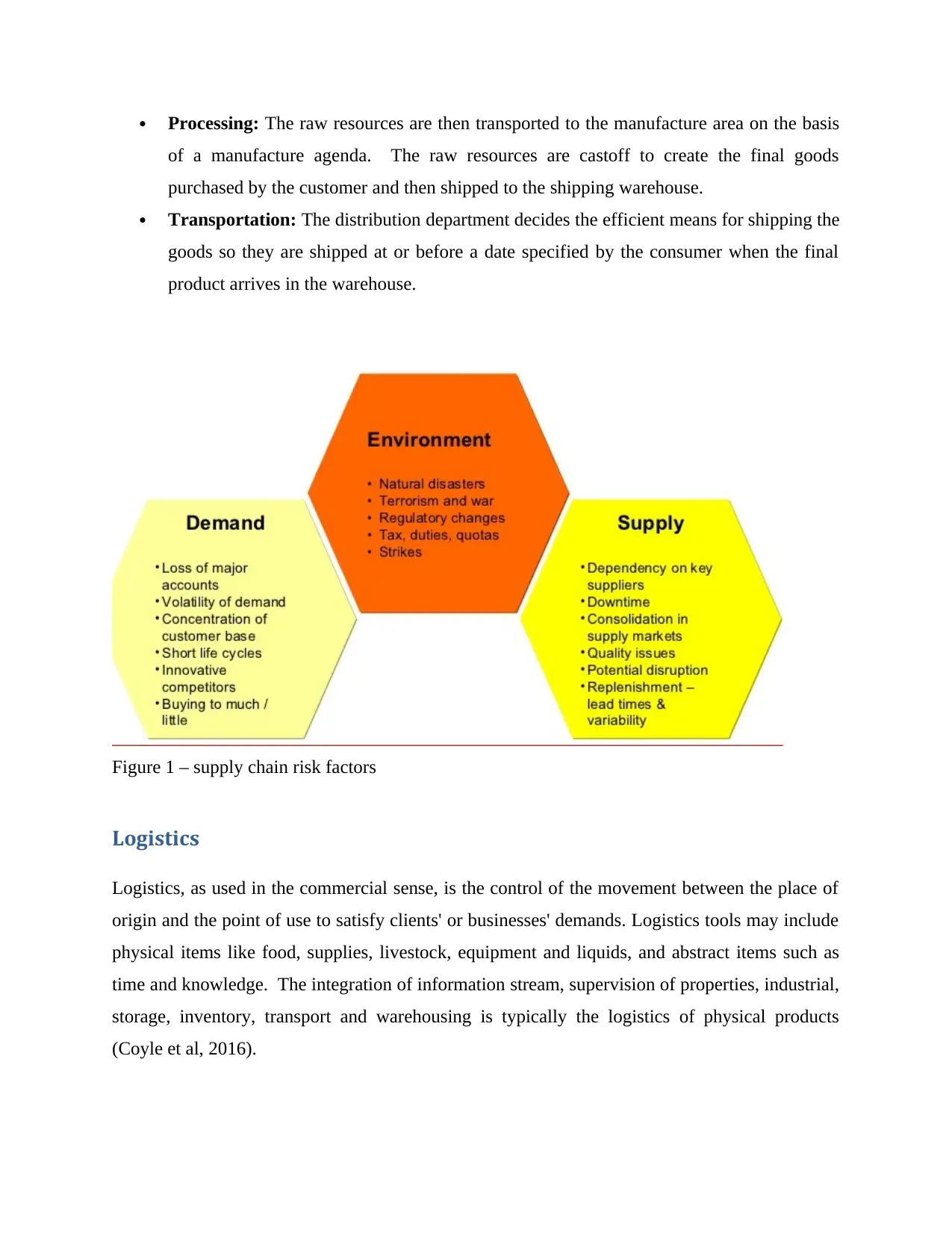
Processing: The raw resources are then transported to the manufacture area on the basis
of a manufacture agenda. The raw resources are castoff to create the final goods
purchased by the customer and then shipped to the shipping warehouse.
Transportation: The distribution department decides the efficient means for shipping the
goods so they are shipped at or before a date specified by the consumer when the final
product arrives in the warehouse.
Figure 1 – supply chain risk factors
Logistics
Logistics, as used in the commercial sense, is the control of the movement between the place of
origin and the point of use to satisfy clients' or businesses' demands. Logistics tools may include
physical items like food, supplies, livestock, equipment and liquids, and abstract items such as
time and knowledge. The integration of information stream, supervision of properties, industrial,
storage, inventory, transport and warehousing is typically the logistics of physical products
(Coyle et al, 2016).
of a manufacture agenda. The raw resources are castoff to create the final goods
purchased by the customer and then shipped to the shipping warehouse.
Transportation: The distribution department decides the efficient means for shipping the
goods so they are shipped at or before a date specified by the consumer when the final
product arrives in the warehouse.
Figure 1 – supply chain risk factors
Logistics
Logistics, as used in the commercial sense, is the control of the movement between the place of
origin and the point of use to satisfy clients' or businesses' demands. Logistics tools may include
physical items like food, supplies, livestock, equipment and liquids, and abstract items such as
time and knowledge. The integration of information stream, supervision of properties, industrial,
storage, inventory, transport and warehousing is typically the logistics of physical products
(Coyle et al, 2016).
Paraphrase This Document
Need a fresh take? Get an instant paraphrase of this document with our AI Paraphraser
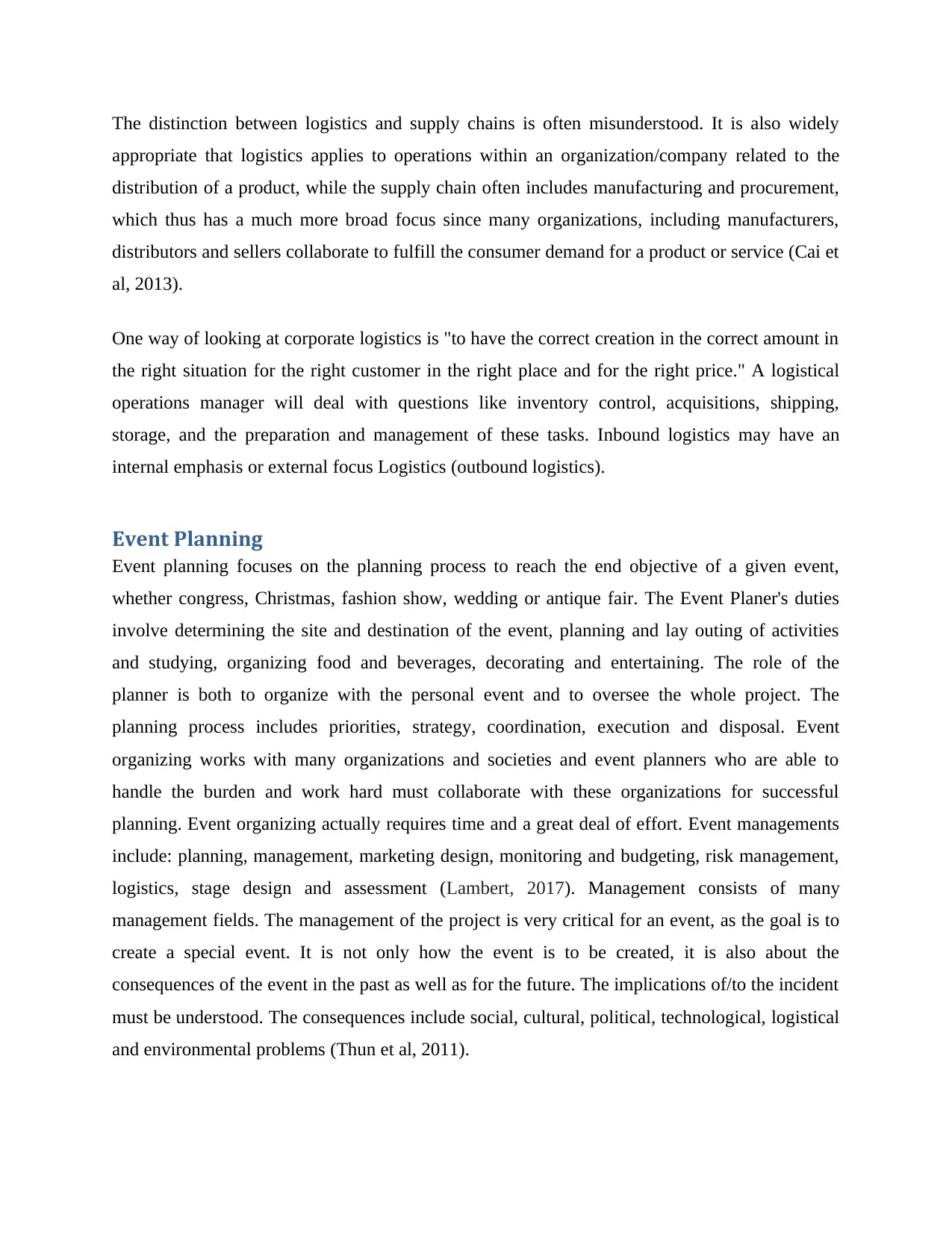
The distinction between logistics and supply chains is often misunderstood. It is also widely
appropriate that logistics applies to operations within an organization/company related to the
distribution of a product, while the supply chain often includes manufacturing and procurement,
which thus has a much more broad focus since many organizations, including manufacturers,
distributors and sellers collaborate to fulfill the consumer demand for a product or service (Cai et
al, 2013).
One way of looking at corporate logistics is "to have the correct creation in the correct amount in
the right situation for the right customer in the right place and for the right price." A logistical
operations manager will deal with questions like inventory control, acquisitions, shipping,
storage, and the preparation and management of these tasks. Inbound logistics may have an
internal emphasis or external focus Logistics (outbound logistics).
Event Planning
Event planning focuses on the planning process to reach the end objective of a given event,
whether congress, Christmas, fashion show, wedding or antique fair. The Event Planer's duties
involve determining the site and destination of the event, planning and lay outing of activities
and studying, organizing food and beverages, decorating and entertaining. The role of the
planner is both to organize with the personal event and to oversee the whole project. The
planning process includes priorities, strategy, coordination, execution and disposal. Event
organizing works with many organizations and societies and event planners who are able to
handle the burden and work hard must collaborate with these organizations for successful
planning. Event organizing actually requires time and a great deal of effort. Event managements
include: planning, management, marketing design, monitoring and budgeting, risk management,
logistics, stage design and assessment (Lambert, 2017). Management consists of many
management fields. The management of the project is very critical for an event, as the goal is to
create a special event. It is not only how the event is to be created, it is also about the
consequences of the event in the past as well as for the future. The implications of/to the incident
must be understood. The consequences include social, cultural, political, technological, logistical
and environmental problems (Thun et al, 2011).
appropriate that logistics applies to operations within an organization/company related to the
distribution of a product, while the supply chain often includes manufacturing and procurement,
which thus has a much more broad focus since many organizations, including manufacturers,
distributors and sellers collaborate to fulfill the consumer demand for a product or service (Cai et
al, 2013).
One way of looking at corporate logistics is "to have the correct creation in the correct amount in
the right situation for the right customer in the right place and for the right price." A logistical
operations manager will deal with questions like inventory control, acquisitions, shipping,
storage, and the preparation and management of these tasks. Inbound logistics may have an
internal emphasis or external focus Logistics (outbound logistics).
Event Planning
Event planning focuses on the planning process to reach the end objective of a given event,
whether congress, Christmas, fashion show, wedding or antique fair. The Event Planer's duties
involve determining the site and destination of the event, planning and lay outing of activities
and studying, organizing food and beverages, decorating and entertaining. The role of the
planner is both to organize with the personal event and to oversee the whole project. The
planning process includes priorities, strategy, coordination, execution and disposal. Event
organizing works with many organizations and societies and event planners who are able to
handle the burden and work hard must collaborate with these organizations for successful
planning. Event organizing actually requires time and a great deal of effort. Event managements
include: planning, management, marketing design, monitoring and budgeting, risk management,
logistics, stage design and assessment (Lambert, 2017). Management consists of many
management fields. The management of the project is very critical for an event, as the goal is to
create a special event. It is not only how the event is to be created, it is also about the
consequences of the event in the past as well as for the future. The implications of/to the incident
must be understood. The consequences include social, cultural, political, technological, logistical
and environmental problems (Thun et al, 2011).
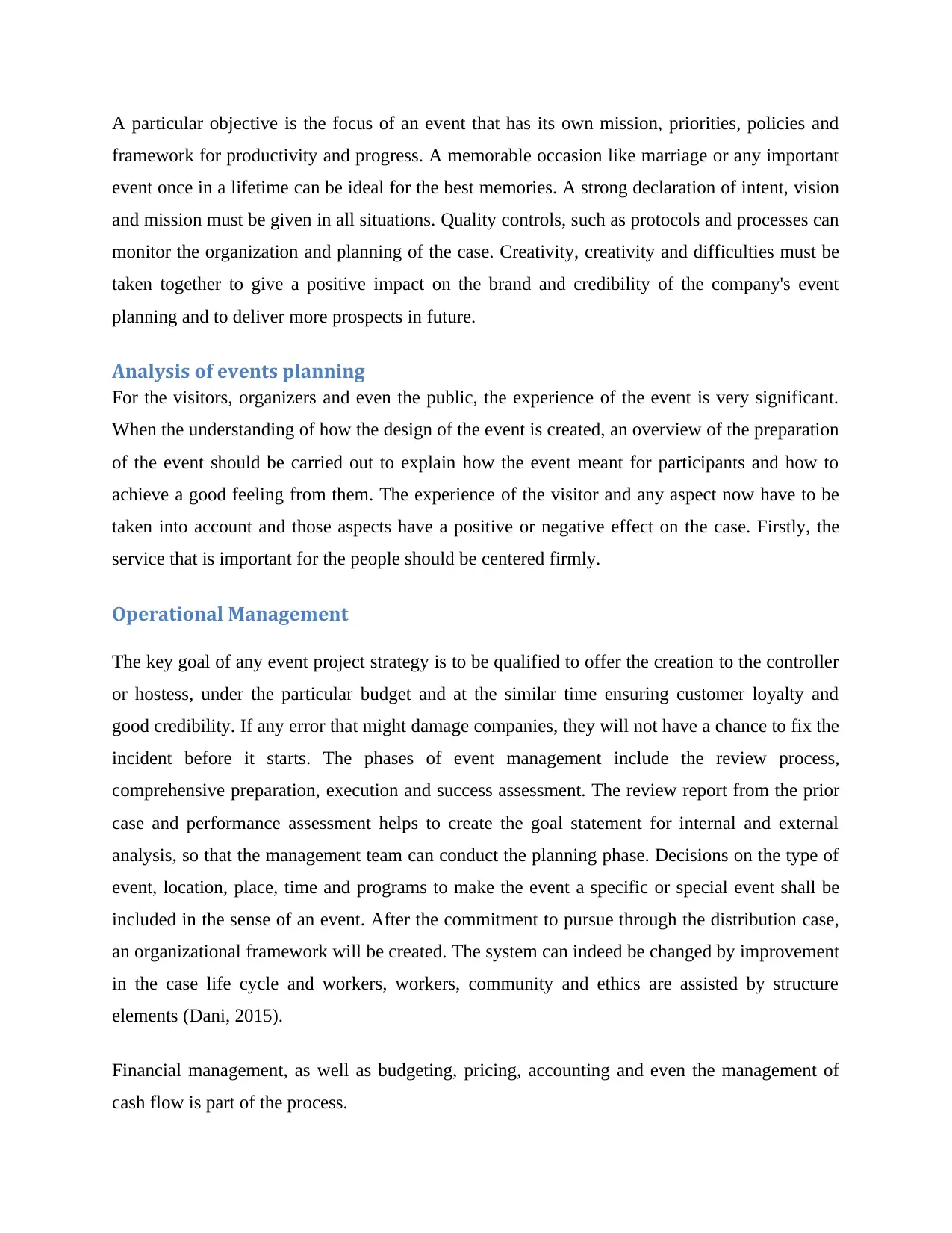
A particular objective is the focus of an event that has its own mission, priorities, policies and
framework for productivity and progress. A memorable occasion like marriage or any important
event once in a lifetime can be ideal for the best memories. A strong declaration of intent, vision
and mission must be given in all situations. Quality controls, such as protocols and processes can
monitor the organization and planning of the case. Creativity, creativity and difficulties must be
taken together to give a positive impact on the brand and credibility of the company's event
planning and to deliver more prospects in future.
Analysis of events planning
For the visitors, organizers and even the public, the experience of the event is very significant.
When the understanding of how the design of the event is created, an overview of the preparation
of the event should be carried out to explain how the event meant for participants and how to
achieve a good feeling from them. The experience of the visitor and any aspect now have to be
taken into account and those aspects have a positive or negative effect on the case. Firstly, the
service that is important for the people should be centered firmly.
Operational Management
The key goal of any event project strategy is to be qualified to offer the creation to the controller
or hostess, under the particular budget and at the similar time ensuring customer loyalty and
good credibility. If any error that might damage companies, they will not have a chance to fix the
incident before it starts. The phases of event management include the review process,
comprehensive preparation, execution and success assessment. The review report from the prior
case and performance assessment helps to create the goal statement for internal and external
analysis, so that the management team can conduct the planning phase. Decisions on the type of
event, location, place, time and programs to make the event a specific or special event shall be
included in the sense of an event. After the commitment to pursue through the distribution case,
an organizational framework will be created. The system can indeed be changed by improvement
in the case life cycle and workers, workers, community and ethics are assisted by structure
elements (Dani, 2015).
Financial management, as well as budgeting, pricing, accounting and even the management of
cash flow is part of the process.
framework for productivity and progress. A memorable occasion like marriage or any important
event once in a lifetime can be ideal for the best memories. A strong declaration of intent, vision
and mission must be given in all situations. Quality controls, such as protocols and processes can
monitor the organization and planning of the case. Creativity, creativity and difficulties must be
taken together to give a positive impact on the brand and credibility of the company's event
planning and to deliver more prospects in future.
Analysis of events planning
For the visitors, organizers and even the public, the experience of the event is very significant.
When the understanding of how the design of the event is created, an overview of the preparation
of the event should be carried out to explain how the event meant for participants and how to
achieve a good feeling from them. The experience of the visitor and any aspect now have to be
taken into account and those aspects have a positive or negative effect on the case. Firstly, the
service that is important for the people should be centered firmly.
Operational Management
The key goal of any event project strategy is to be qualified to offer the creation to the controller
or hostess, under the particular budget and at the similar time ensuring customer loyalty and
good credibility. If any error that might damage companies, they will not have a chance to fix the
incident before it starts. The phases of event management include the review process,
comprehensive preparation, execution and success assessment. The review report from the prior
case and performance assessment helps to create the goal statement for internal and external
analysis, so that the management team can conduct the planning phase. Decisions on the type of
event, location, place, time and programs to make the event a specific or special event shall be
included in the sense of an event. After the commitment to pursue through the distribution case,
an organizational framework will be created. The system can indeed be changed by improvement
in the case life cycle and workers, workers, community and ethics are assisted by structure
elements (Dani, 2015).
Financial management, as well as budgeting, pricing, accounting and even the management of
cash flow is part of the process.
⊘ This is a preview!⊘
Do you want full access?
Subscribe today to unlock all pages.

Trusted by 1+ million students worldwide
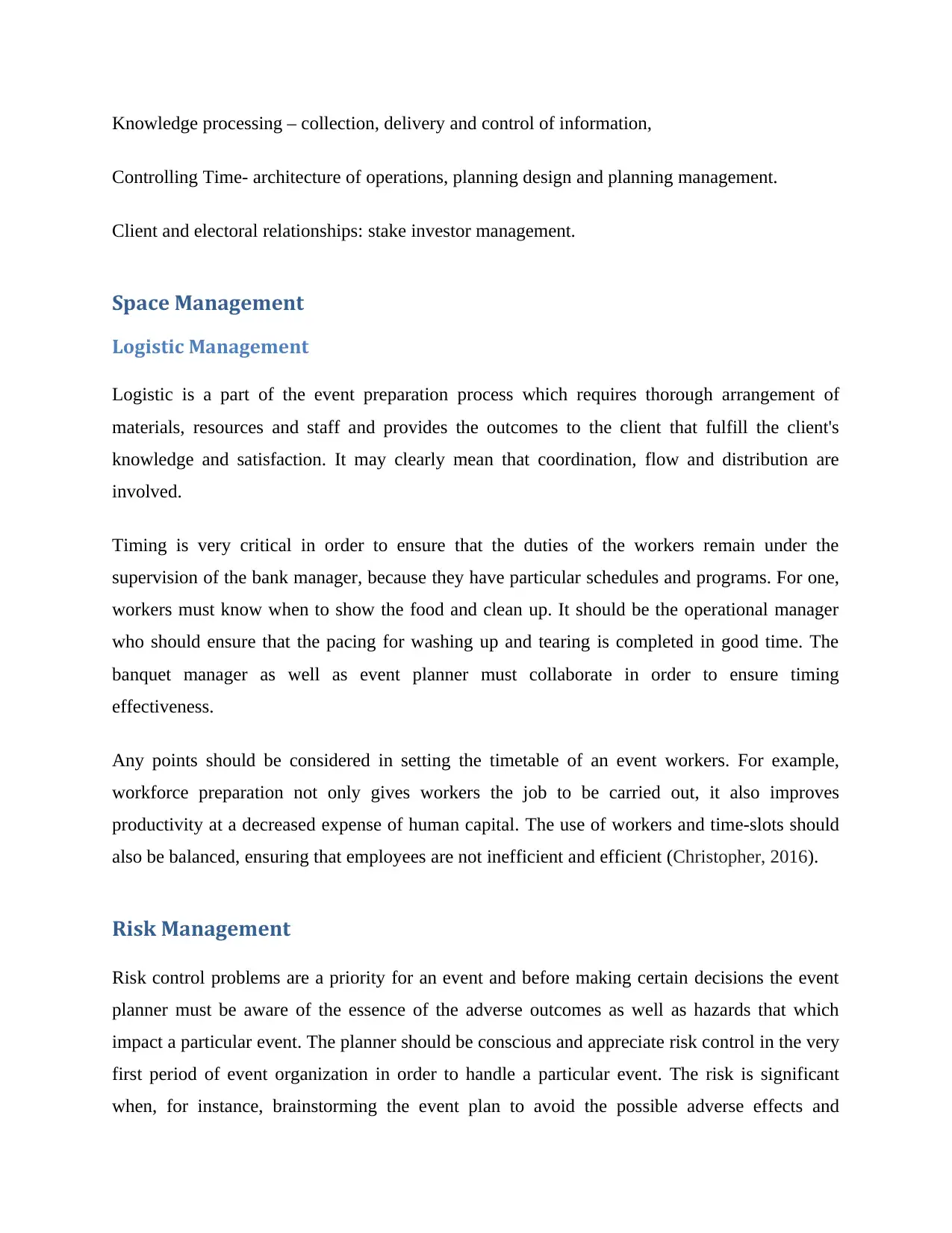
Knowledge processing – collection, delivery and control of information,
Controlling Time- architecture of operations, planning design and planning management.
Client and electoral relationships: stake investor management.
Space Management
Logistic Management
Logistic is a part of the event preparation process which requires thorough arrangement of
materials, resources and staff and provides the outcomes to the client that fulfill the client's
knowledge and satisfaction. It may clearly mean that coordination, flow and distribution are
involved.
Timing is very critical in order to ensure that the duties of the workers remain under the
supervision of the bank manager, because they have particular schedules and programs. For one,
workers must know when to show the food and clean up. It should be the operational manager
who should ensure that the pacing for washing up and tearing is completed in good time. The
banquet manager as well as event planner must collaborate in order to ensure timing
effectiveness.
Any points should be considered in setting the timetable of an event workers. For example,
workforce preparation not only gives workers the job to be carried out, it also improves
productivity at a decreased expense of human capital. The use of workers and time-slots should
also be balanced, ensuring that employees are not inefficient and efficient (Christopher, 2016).
Risk Management
Risk control problems are a priority for an event and before making certain decisions the event
planner must be aware of the essence of the adverse outcomes as well as hazards that which
impact a particular event. The planner should be conscious and appreciate risk control in the very
first period of event organization in order to handle a particular event. The risk is significant
when, for instance, brainstorming the event plan to avoid the possible adverse effects and
Controlling Time- architecture of operations, planning design and planning management.
Client and electoral relationships: stake investor management.
Space Management
Logistic Management
Logistic is a part of the event preparation process which requires thorough arrangement of
materials, resources and staff and provides the outcomes to the client that fulfill the client's
knowledge and satisfaction. It may clearly mean that coordination, flow and distribution are
involved.
Timing is very critical in order to ensure that the duties of the workers remain under the
supervision of the bank manager, because they have particular schedules and programs. For one,
workers must know when to show the food and clean up. It should be the operational manager
who should ensure that the pacing for washing up and tearing is completed in good time. The
banquet manager as well as event planner must collaborate in order to ensure timing
effectiveness.
Any points should be considered in setting the timetable of an event workers. For example,
workforce preparation not only gives workers the job to be carried out, it also improves
productivity at a decreased expense of human capital. The use of workers and time-slots should
also be balanced, ensuring that employees are not inefficient and efficient (Christopher, 2016).
Risk Management
Risk control problems are a priority for an event and before making certain decisions the event
planner must be aware of the essence of the adverse outcomes as well as hazards that which
impact a particular event. The planner should be conscious and appreciate risk control in the very
first period of event organization in order to handle a particular event. The risk is significant
when, for instance, brainstorming the event plan to avoid the possible adverse effects and
Paraphrase This Document
Need a fresh take? Get an instant paraphrase of this document with our AI Paraphraser
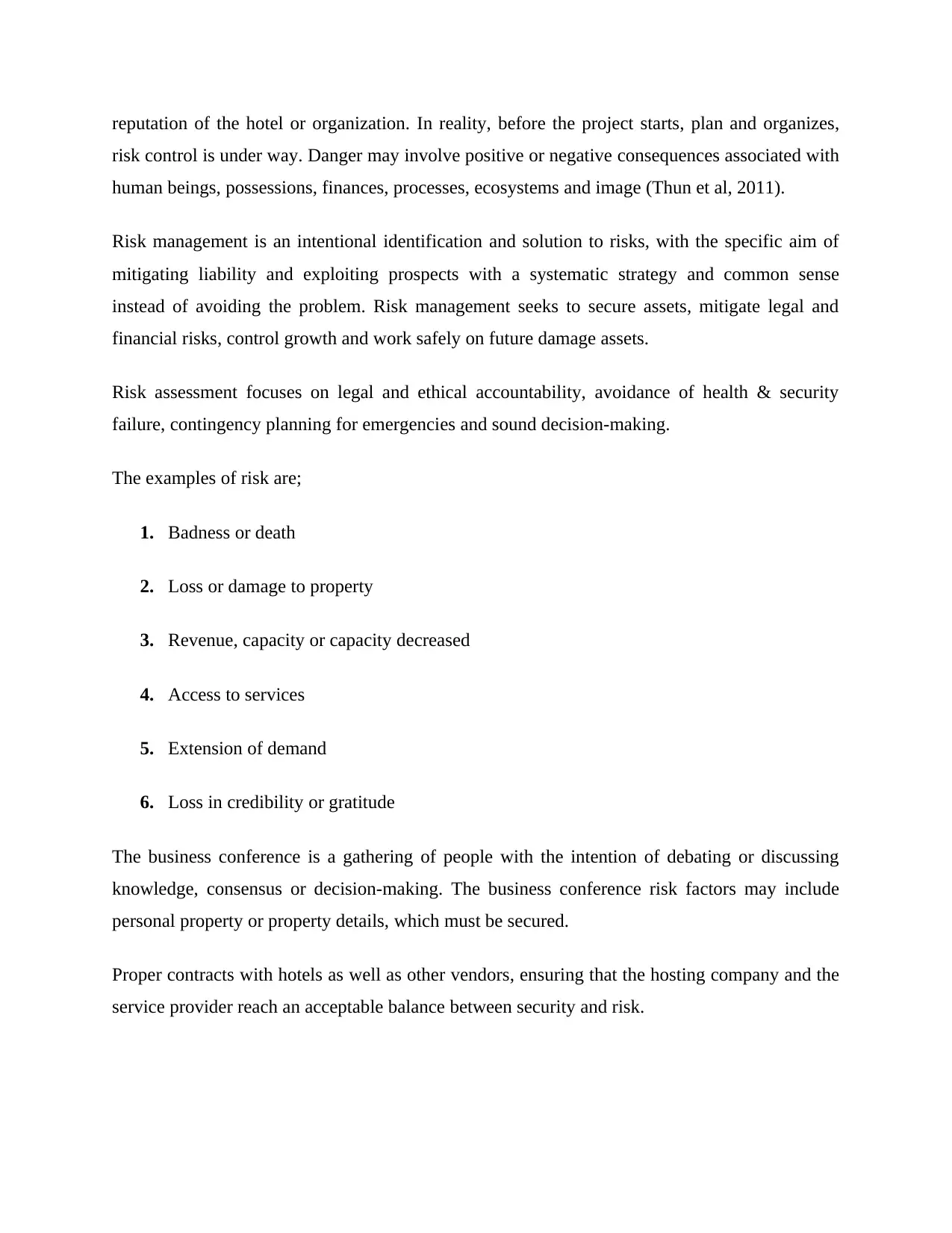
reputation of the hotel or organization. In reality, before the project starts, plan and organizes,
risk control is under way. Danger may involve positive or negative consequences associated with
human beings, possessions, finances, processes, ecosystems and image (Thun et al, 2011).
Risk management is an intentional identification and solution to risks, with the specific aim of
mitigating liability and exploiting prospects with a systematic strategy and common sense
instead of avoiding the problem. Risk management seeks to secure assets, mitigate legal and
financial risks, control growth and work safely on future damage assets.
Risk assessment focuses on legal and ethical accountability, avoidance of health & security
failure, contingency planning for emergencies and sound decision-making.
The examples of risk are;
1. Badness or death
2. Loss or damage to property
3. Revenue, capacity or capacity decreased
4. Access to services
5. Extension of demand
6. Loss in credibility or gratitude
The business conference is a gathering of people with the intention of debating or discussing
knowledge, consensus or decision-making. The business conference risk factors may include
personal property or property details, which must be secured.
Proper contracts with hotels as well as other vendors, ensuring that the hosting company and the
service provider reach an acceptable balance between security and risk.
risk control is under way. Danger may involve positive or negative consequences associated with
human beings, possessions, finances, processes, ecosystems and image (Thun et al, 2011).
Risk management is an intentional identification and solution to risks, with the specific aim of
mitigating liability and exploiting prospects with a systematic strategy and common sense
instead of avoiding the problem. Risk management seeks to secure assets, mitigate legal and
financial risks, control growth and work safely on future damage assets.
Risk assessment focuses on legal and ethical accountability, avoidance of health & security
failure, contingency planning for emergencies and sound decision-making.
The examples of risk are;
1. Badness or death
2. Loss or damage to property
3. Revenue, capacity or capacity decreased
4. Access to services
5. Extension of demand
6. Loss in credibility or gratitude
The business conference is a gathering of people with the intention of debating or discussing
knowledge, consensus or decision-making. The business conference risk factors may include
personal property or property details, which must be secured.
Proper contracts with hotels as well as other vendors, ensuring that the hosting company and the
service provider reach an acceptable balance between security and risk.
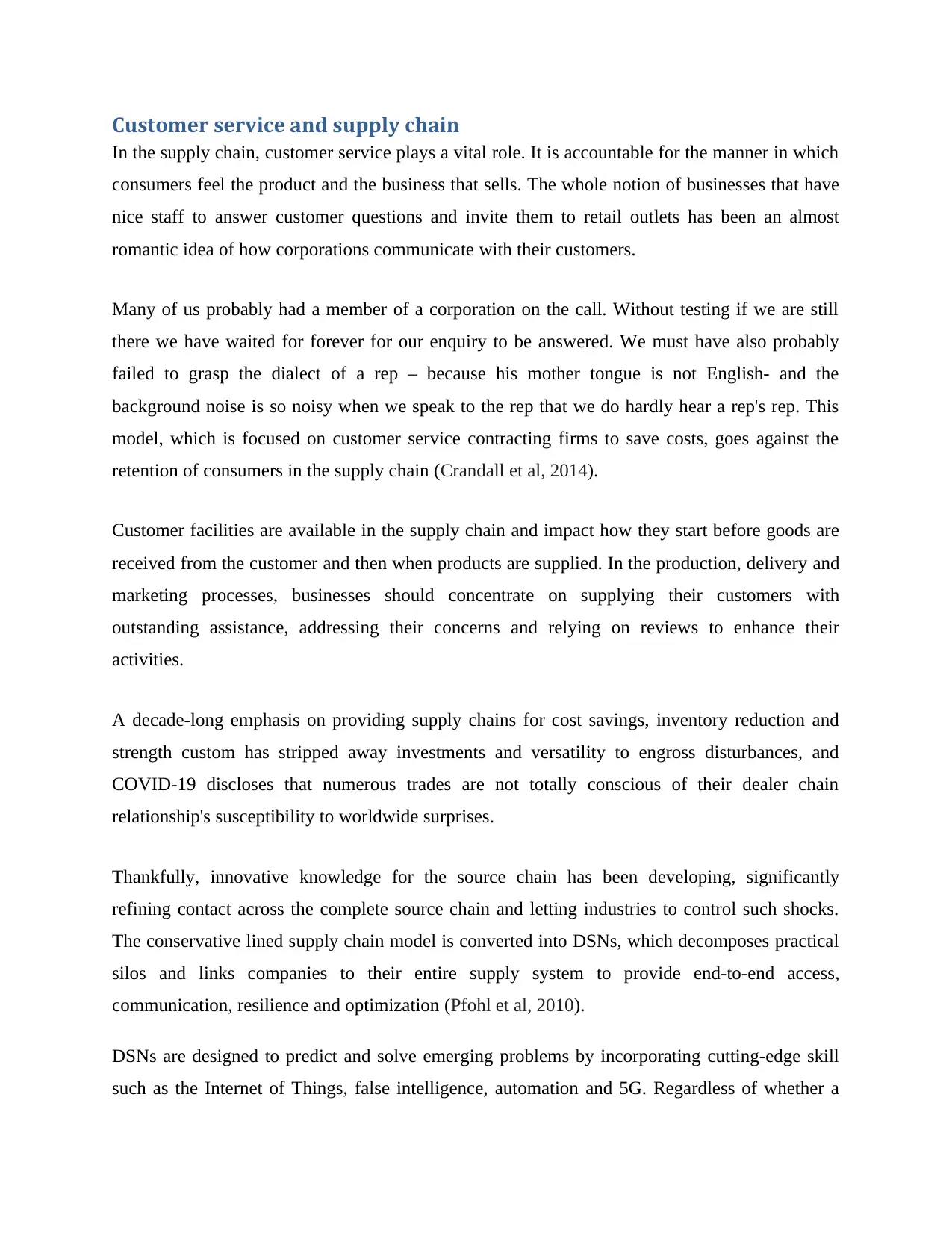
Customer service and supply chain
In the supply chain, customer service plays a vital role. It is accountable for the manner in which
consumers feel the product and the business that sells. The whole notion of businesses that have
nice staff to answer customer questions and invite them to retail outlets has been an almost
romantic idea of how corporations communicate with their customers.
Many of us probably had a member of a corporation on the call. Without testing if we are still
there we have waited for forever for our enquiry to be answered. We must have also probably
failed to grasp the dialect of a rep – because his mother tongue is not English- and the
background noise is so noisy when we speak to the rep that we do hardly hear a rep's rep. This
model, which is focused on customer service contracting firms to save costs, goes against the
retention of consumers in the supply chain (Crandall et al, 2014).
Customer facilities are available in the supply chain and impact how they start before goods are
received from the customer and then when products are supplied. In the production, delivery and
marketing processes, businesses should concentrate on supplying their customers with
outstanding assistance, addressing their concerns and relying on reviews to enhance their
activities.
A decade-long emphasis on providing supply chains for cost savings, inventory reduction and
strength custom has stripped away investments and versatility to engross disturbances, and
COVID-19 discloses that numerous trades are not totally conscious of their dealer chain
relationship's susceptibility to worldwide surprises.
Thankfully, innovative knowledge for the source chain has been developing, significantly
refining contact across the complete source chain and letting industries to control such shocks.
The conservative lined supply chain model is converted into DSNs, which decomposes practical
silos and links companies to their entire supply system to provide end-to-end access,
communication, resilience and optimization (Pfohl et al, 2010).
DSNs are designed to predict and solve emerging problems by incorporating cutting-edge skill
such as the Internet of Things, false intelligence, automation and 5G. Regardless of whether a
In the supply chain, customer service plays a vital role. It is accountable for the manner in which
consumers feel the product and the business that sells. The whole notion of businesses that have
nice staff to answer customer questions and invite them to retail outlets has been an almost
romantic idea of how corporations communicate with their customers.
Many of us probably had a member of a corporation on the call. Without testing if we are still
there we have waited for forever for our enquiry to be answered. We must have also probably
failed to grasp the dialect of a rep – because his mother tongue is not English- and the
background noise is so noisy when we speak to the rep that we do hardly hear a rep's rep. This
model, which is focused on customer service contracting firms to save costs, goes against the
retention of consumers in the supply chain (Crandall et al, 2014).
Customer facilities are available in the supply chain and impact how they start before goods are
received from the customer and then when products are supplied. In the production, delivery and
marketing processes, businesses should concentrate on supplying their customers with
outstanding assistance, addressing their concerns and relying on reviews to enhance their
activities.
A decade-long emphasis on providing supply chains for cost savings, inventory reduction and
strength custom has stripped away investments and versatility to engross disturbances, and
COVID-19 discloses that numerous trades are not totally conscious of their dealer chain
relationship's susceptibility to worldwide surprises.
Thankfully, innovative knowledge for the source chain has been developing, significantly
refining contact across the complete source chain and letting industries to control such shocks.
The conservative lined supply chain model is converted into DSNs, which decomposes practical
silos and links companies to their entire supply system to provide end-to-end access,
communication, resilience and optimization (Pfohl et al, 2010).
DSNs are designed to predict and solve emerging problems by incorporating cutting-edge skill
such as the Internet of Things, false intelligence, automation and 5G. Regardless of whether a
⊘ This is a preview!⊘
Do you want full access?
Subscribe today to unlock all pages.

Trusted by 1+ million students worldwide
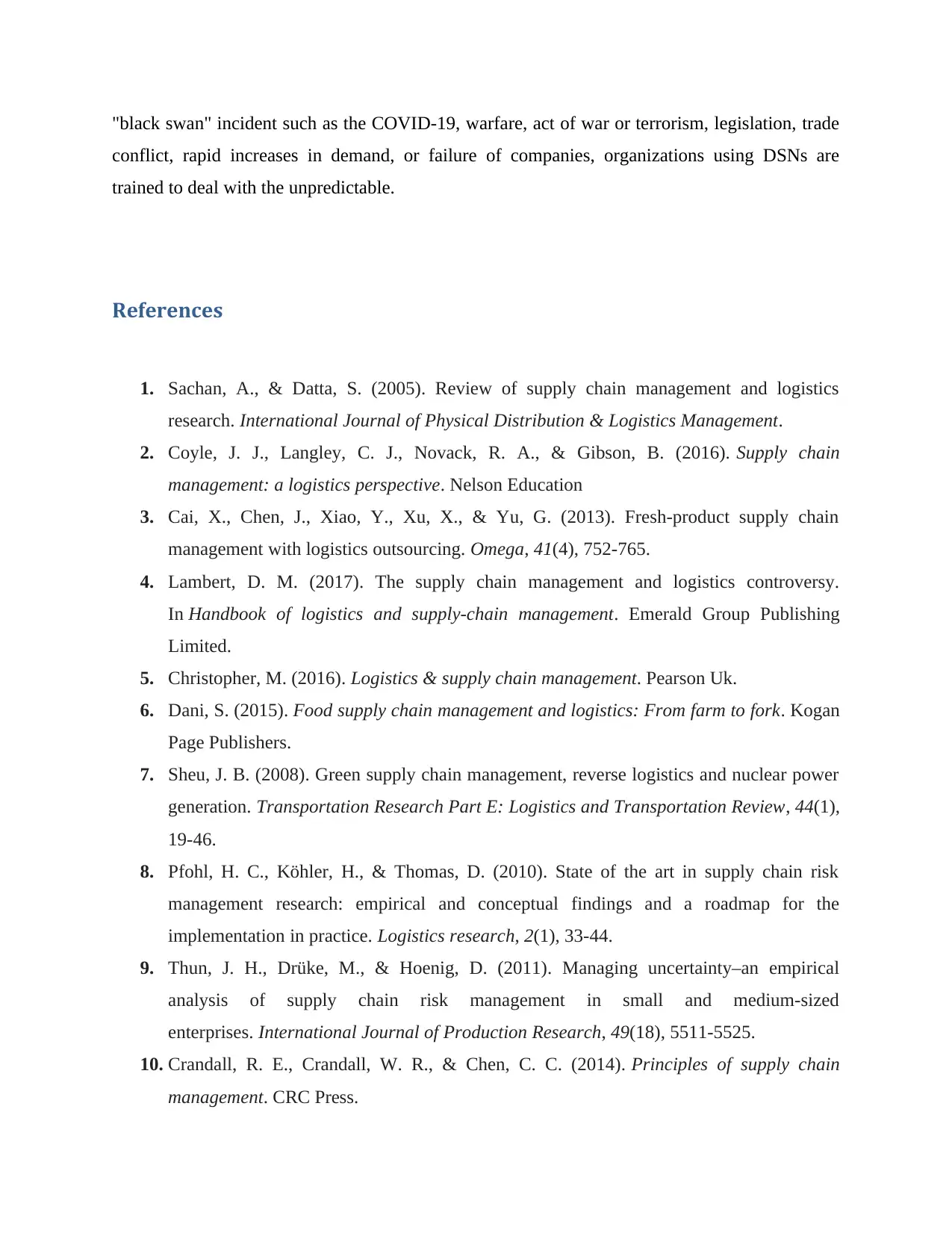
"black swan" incident such as the COVID-19, warfare, act of war or terrorism, legislation, trade
conflict, rapid increases in demand, or failure of companies, organizations using DSNs are
trained to deal with the unpredictable.
References
1. Sachan, A., & Datta, S. (2005). Review of supply chain management and logistics
research. International Journal of Physical Distribution & Logistics Management.
2. Coyle, J. J., Langley, C. J., Novack, R. A., & Gibson, B. (2016). Supply chain
management: a logistics perspective. Nelson Education
3. Cai, X., Chen, J., Xiao, Y., Xu, X., & Yu, G. (2013). Fresh-product supply chain
management with logistics outsourcing. Omega, 41(4), 752-765.
4. Lambert, D. M. (2017). The supply chain management and logistics controversy.
In Handbook of logistics and supply-chain management. Emerald Group Publishing
Limited.
5. Christopher, M. (2016). Logistics & supply chain management. Pearson Uk.
6. Dani, S. (2015). Food supply chain management and logistics: From farm to fork. Kogan
Page Publishers.
7. Sheu, J. B. (2008). Green supply chain management, reverse logistics and nuclear power
generation. Transportation Research Part E: Logistics and Transportation Review, 44(1),
19-46.
8. Pfohl, H. C., Köhler, H., & Thomas, D. (2010). State of the art in supply chain risk
management research: empirical and conceptual findings and a roadmap for the
implementation in practice. Logistics research, 2(1), 33-44.
9. Thun, J. H., Drüke, M., & Hoenig, D. (2011). Managing uncertainty–an empirical
analysis of supply chain risk management in small and medium-sized
enterprises. International Journal of Production Research, 49(18), 5511-5525.
10. Crandall, R. E., Crandall, W. R., & Chen, C. C. (2014). Principles of supply chain
management. CRC Press.
conflict, rapid increases in demand, or failure of companies, organizations using DSNs are
trained to deal with the unpredictable.
References
1. Sachan, A., & Datta, S. (2005). Review of supply chain management and logistics
research. International Journal of Physical Distribution & Logistics Management.
2. Coyle, J. J., Langley, C. J., Novack, R. A., & Gibson, B. (2016). Supply chain
management: a logistics perspective. Nelson Education
3. Cai, X., Chen, J., Xiao, Y., Xu, X., & Yu, G. (2013). Fresh-product supply chain
management with logistics outsourcing. Omega, 41(4), 752-765.
4. Lambert, D. M. (2017). The supply chain management and logistics controversy.
In Handbook of logistics and supply-chain management. Emerald Group Publishing
Limited.
5. Christopher, M. (2016). Logistics & supply chain management. Pearson Uk.
6. Dani, S. (2015). Food supply chain management and logistics: From farm to fork. Kogan
Page Publishers.
7. Sheu, J. B. (2008). Green supply chain management, reverse logistics and nuclear power
generation. Transportation Research Part E: Logistics and Transportation Review, 44(1),
19-46.
8. Pfohl, H. C., Köhler, H., & Thomas, D. (2010). State of the art in supply chain risk
management research: empirical and conceptual findings and a roadmap for the
implementation in practice. Logistics research, 2(1), 33-44.
9. Thun, J. H., Drüke, M., & Hoenig, D. (2011). Managing uncertainty–an empirical
analysis of supply chain risk management in small and medium-sized
enterprises. International Journal of Production Research, 49(18), 5511-5525.
10. Crandall, R. E., Crandall, W. R., & Chen, C. C. (2014). Principles of supply chain
management. CRC Press.
Paraphrase This Document
Need a fresh take? Get an instant paraphrase of this document with our AI Paraphraser
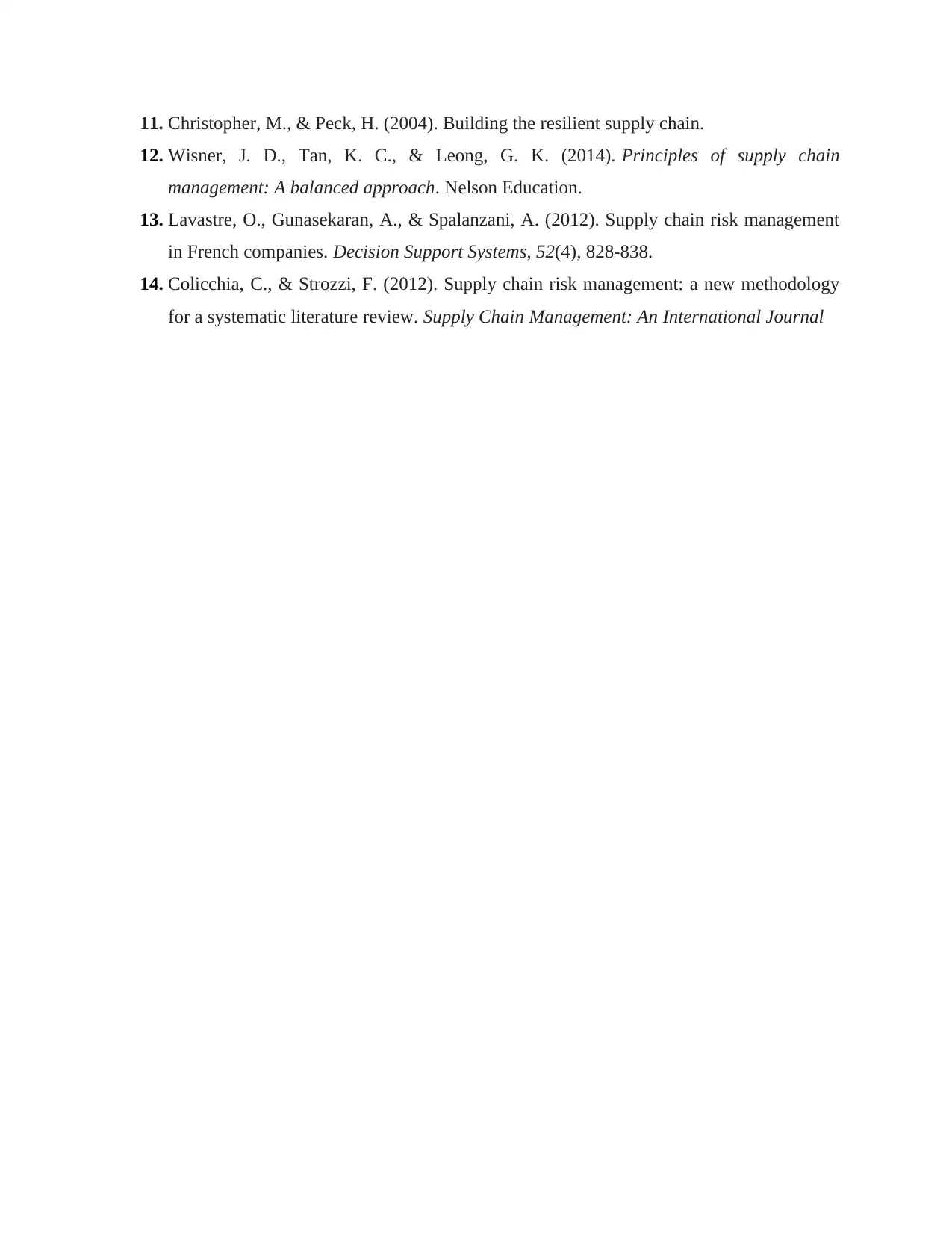
11. Christopher, M., & Peck, H. (2004). Building the resilient supply chain.
12. Wisner, J. D., Tan, K. C., & Leong, G. K. (2014). Principles of supply chain
management: A balanced approach. Nelson Education.
13. Lavastre, O., Gunasekaran, A., & Spalanzani, A. (2012). Supply chain risk management
in French companies. Decision Support Systems, 52(4), 828-838.
14. Colicchia, C., & Strozzi, F. (2012). Supply chain risk management: a new methodology
for a systematic literature review. Supply Chain Management: An International Journal
12. Wisner, J. D., Tan, K. C., & Leong, G. K. (2014). Principles of supply chain
management: A balanced approach. Nelson Education.
13. Lavastre, O., Gunasekaran, A., & Spalanzani, A. (2012). Supply chain risk management
in French companies. Decision Support Systems, 52(4), 828-838.
14. Colicchia, C., & Strozzi, F. (2012). Supply chain risk management: a new methodology
for a systematic literature review. Supply Chain Management: An International Journal
1 out of 11
Related Documents
Your All-in-One AI-Powered Toolkit for Academic Success.
+13062052269
info@desklib.com
Available 24*7 on WhatsApp / Email
![[object Object]](/_next/static/media/star-bottom.7253800d.svg)
Unlock your academic potential
Copyright © 2020–2025 A2Z Services. All Rights Reserved. Developed and managed by ZUCOL.
![Detailed Report on Transport and Logistics Management for [Date]](/_next/image/?url=https%3A%2F%2Fdesklib.com%2Fmedia%2Fimages%2Fen%2Fd53a44a51cb74f96838485f723fb79dd.jpg&w=256&q=75)




